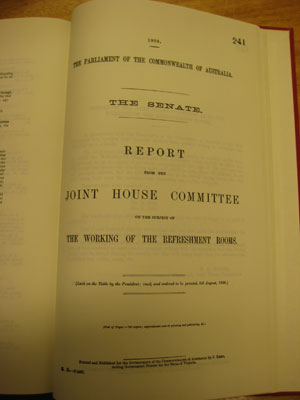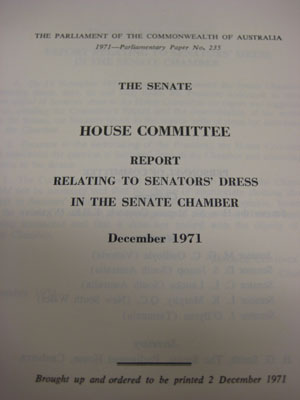Standing Committees
21 House
-
A House Committee, consisting of the President, the Deputy President and 5 senators, shall be appointed at the commencement of each Parliament, with power to act during recess, and to confer and sit as a joint committee with a similar committee of the House of Representatives.
-
The committee may consider any matter relating to the provision of facilities in Parliament House referred to it by the Senate or by the President.
-
The President shall be the chair of the committee.
Amendment history
Adopted: 19 August 1903 as SO 35 (corresponding to paragraph (1))
Amended:
- 2 December 1965, J.427 (to take effect 1 January 1966) (changes in terminology and timing: committee to be appointed at the beginning of each “Parliament” rather than each “Session”)
- 24 August 1994, J.2053 (to take effect 10 October 1994) (Deputy President designated as chair in new paragraph (3) and as an ex officio member in paragraph (1) in place of the President)
- 13 November 2002, J.1053 (President replaced Deputy President as chair and was re-included as an ex officio member)
1989 revision: Old SO 35 renumbered as SO 21 and committee functions specified in paragraph (2)
Commentary

Report of the House Committee, 1906
The House Committee is the most literally domestic of the domestic standing committees because its role is to monitor the provision of facilities and services in Parliament House, chiefly (though not exclusively) those facilities and services provided to senators and members. The committee usually functions as a joint committee, meeting with its House of Representatives counterpart, although the 1938 MS records occasional meetings on its own to consider some specific matter relating only to the Senate.
See SO 20 for an account of the controversy surrounding the appointment of additional members by the House of Representatives, which came to a head in 1929 with President Kingsmill’s refusal to preside over a meeting of a joint committee which did not afford equal representation to both Houses.[1]
As was the case with the Procedure Committee and the Library Committee, the 1989 revision added paragraph (2). The purpose of this addition, according to the summary of proposed changes of substance tabled with the first draft of the revision, was to include a statement in general terms of what the committee was intended to do.[2]

Report of the House Committee
In 1994, following the restructuring of the legislative and general purpose standing committees and the concomitant reallocation of a number of committee chairs to non-government senators in order to more accurately reflect the composition of the Senate, the Deputy President was designated as the chair of the House Committee and as an ex officio member in place of the President.
These new arrangements were ignored in practice, however, and the Deputy President moved a motion in the Senate on 13 November 2002 to re-align the standing order with practice. In a short statement of explanation, the Deputy President indicated that the President had continued to chair meetings of the Joint House Committee. The proposed amendment would regularise this and ensure that both the President and Deputy President were ex officio members of the committee.[3]
The committee has not presented a report in recent years[4] but has been closely involved with the domestic affairs of the Parliament including monitoring of catering contracts and the long-running deliberations on the establishment of a childcare centre which finally opened in February 2009. The committee has been granted inquiry powers on occasion in order to undertake more complex inquiries including into the management of the former Joint House Department in the1980s.[5]